― David Gemmell, Sword in the Storm
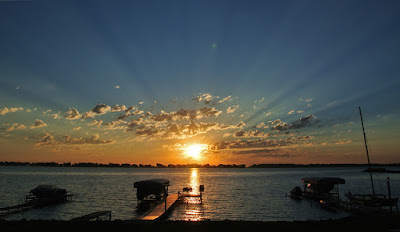
Sunrise over Johnson Lake.
Though I knew of the event for over a year, I wasn't planning on traveling to see the Great American Solar Eclipse of 2017. But then in early July I received the following email from my friend Nancy:
I want to have you think about a plan that I have set in front of Sylvia. I would love to see the August 21st eclipse and we could do it in southern Iowa. I have looked at the maps and we could get almost a total. I think we could drive my car the day before and see it the next day. I have ulterior motives in that you have such outstanding telescopic equipment. It would be a quick trip and a bit of driving. Sylvia is sort of interested. Just an idea.I replied:
If I decide to go ― and that's a big "IF" ― then I think it's worth going all the way to see it in totality.And thus began what would turn out to be a very exciting and memorable trip to Nebraska. Plus, my birthday is August 21st, so why not go for it, right?
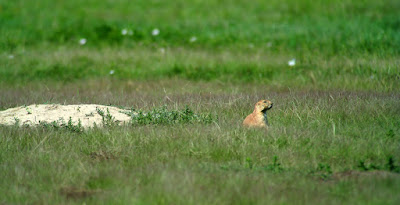
Prairie Dog
Naturally, the trip wouldn't only be about the solar eclipse. Arriving a day early to scout for an eclipse viewing location, we found time to take in some Nebraska birding. Checking eBird reports for the area, I found a promising lead on a recent Burrowing Owl sighting at Prairie Dog Federal Waterfowl Production Area several miles south of Kearney. Burrowing Owl? That'd be a life bird!
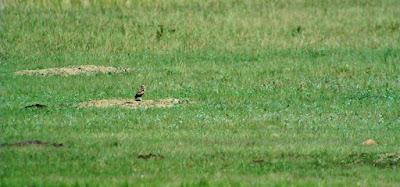
Burrowing Owl!
Once at the prairie dog town, I began scoping across the fields and dirt mounds. The prairie dogs were not too thrilled about our presence and let us know by jump-yipping. We weren't certain of the exact location of the owls, so it took us bit of scanning. Eventually, I spotted one perched near the entrance of its burrow. And then we found another, and another! We never saw more than four at one time, but there may have been others.

Another Burrowing Owl!
The birds were around 250 yards north of the road, so I wasn't able to get close-up portraits. Still, watching them through my spotting scope was extremely cool. Nancy and Sylvia got a kick out of my celebratory "life bird" dance around my tripod and scope.

Looking at birders.

Our base camp was a beautiful lake house on Johnson Lake. Our hosts, some of Nancy's relatives, were unbelievably generous with their time, food, and supplies. The sunrises and sunsets at the lake were some of the most beautiful I've ever seen. One night I gave a brief tour of our galaxy by pointing out various constellations, stars, star clusters, and nebulae, showing them Messier 8, 13, and 31 through a telescope. I can't recall seeing the Milky Way so clearly.

Eclipse Day!
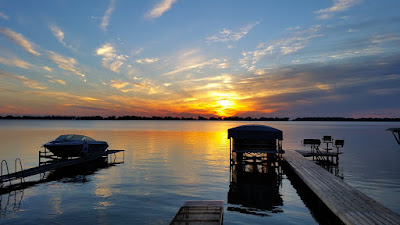
After saying farewell to our wonderful hosts, we set out for Grafton. We didn't know what the traffic situation was like on I80, so we took various highways to the south to get to our destination. Once at Grafton, we headed north on a gravel road until we found a nice spot at a Y-intersection where a few other eclipse watchers were waiting.

Getting ready at 40°41'54.73" N 97°42'36.31" W

Projecting the partial phase from my spotting scope.

Nancy and Sylvia viewing with their solar glasses.

One of our neighbors projects the eclipse onto a plate!

Hazy conditions.
Despite hazy skies, I was able to photograph the partial phase with my Celestron Schmidt-Cassegrain 8" telescope, Thousand Oaks solar filter, and Nikon 1 V1. It's the identical setup and camera configuration I used to photograph the 2012 Venus Transit.

Partial through my C8 SCT.
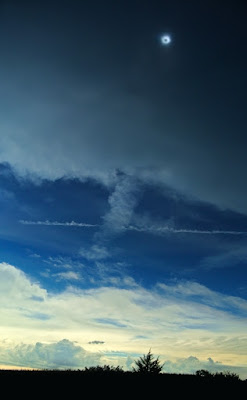
Nikon 1 V1 & 10mm.
I managed to get one decent shot of totality with my Nikon 1 V1 and 10mm lens (tripod mounted), though it was filtered by the hazy clouds. I had preset my iPad's clock to sound an alarm at the moment of totality, and then a second alarm at 2 minutes when there was 35 seconds of totality remaining. When the first alarm went off, I just laid on the shutter button without looking too closely at what I was capturing. When I took a look through my unfiltered spotting scope and saw the fantastic view, I instantly went into "field trip leader" mode and let people and their kids see it, too.
At this point I stopped photographing the eclipse and tried to take in the experience. It was interesting listening to how insects (crickets and cicadas) and birds responded to the rapidly darkening, and then lightening skies―the bugs got louder, the birds quit singing. Perhaps it was a coincidence, but the breeze seemed to subside, too. As totality came to an end, the returning daylight took on a dreamy quality I've never observed anywhere else in nature.
And then there was the long drive home. Things were going fine until we hit a severe thunderstorm in western Iowa on I80. Traffic came to a complete stop and didn't improve beyond much of a crawl for a long time. We decided to take a break and have dinner in Stuart. It was there that we heard there were a couple of accidents further to the west, which was partially responsible for the stalled traffic.

We took another look at traffic on I80 after dinner; the situation hadn't at all improved. Thus, we decided to drive north to Highway 30 to get to Cedar Rapids. Traffic was sparse, but the speed limit was reduced and we had to go through several towns as well. We didn't get home until around 3AM. The last two hours were very tough, but caffeine kept me going.
Nebraska Trip Birds
August 19th - August 21st, 2017
Turkey Vulture
Northern Harrier
Red-tailed Hawk
Killdeer
Upland Sandpiper
Least Sandpiper
Franklin's Gull
Ring-billed Gull
Rock Pigeon
Eurasian Collared-Dove
Mourning Dove
Great Horned Owl
Burrowing Owl
Ruby-throated Hummingbird
Belted Kingfisher
Red-headed Woodpecker
Hairy Woodpecker
Northern Flicker
American Kestrel
Western Kingbird
Eastern Kingbird
Bell's Vireo
Warbling Vireo
Blue Jay
Black-billed Magpie
American Crow
Horned Lark
Bank Swallow
Cliff Swallow
Barn Swallow
House Wren
American Robin
Gray Catbird
European Starling
Chipping Sparrow
Lark Sparrow
Song Sparrow
Indigo Bunting
Dickcissel
Red-winged Blackbird
Western Meadowlark
Common Grackle
Great-tailed Grackle
Orchard Oriole
Baltimore Oriole
House Finch
American Goldfinch
House Sparrow
All images © 2017 Mike McDowell


